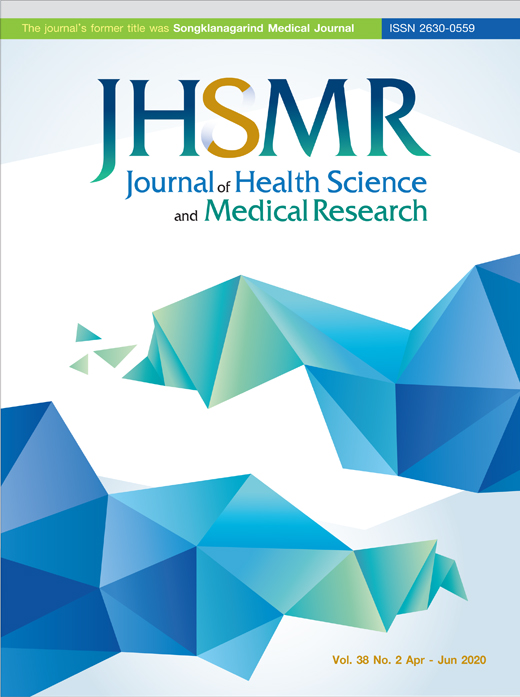Assessment of Average Glandular Dose Received in Full-field Digital Mammography and Digital Breast Tomosynthesis
DOI:
https://doi.org/10.31584/jhsmr.2020730Keywords:
average glandular dose, breast, digital breast tomosynthesis, digital full-field mammography, mammographyAbstract
Objective: To assess the average glandular doses (AGD) from full-field digital mammography (FFDM) and digital breast tomosynthesis (DBT).
Material and Methods: Radiographic exposure parameters target/filter, tube voltage, and tube current were collected from 50 patients. Patient information including age, breast thickness, entrance surface air kerma (ESAK) and AGD from the monitor display were also recorded. The tube outputs (tube voltage and tube loadings) at the reference points in both FFDM and DBT modes were measured. The AGD was calculated from ESAK by using the correction factors following the Technical Report Series no. 457 protocol. For the DBT mode, the AGD was calculated and corrected for the X-ray gantry rotation following the Dance et al. method.
Results: The radiation doses to breasts in terms of ESAK and AGD from FFDM were 4.97±2.29 and 1.36±0.48 milligray (mGy) respectively. The third quartiles were 6.5 mGy and 1.67 mGy, findings which were lower than the standard Dose Reference Levels reported by the International Atomic Energy Agency recommendation (AGD 3 mGy/view for standard breast thickness with grid). For the DBT mode, ESAK and AGD were 6.49±2.10 mGy and 1.63±0.51 mGy. The third quartiles were 7.68 mGy and 1.81 mGy which were more than the FFDM mode by 23.0% and 17.0%, respectively.
Conclusion: This study found that the AGD received from the DBT mode was higher than from the FFDM mode. Patients who underwent combination modes of mammographic examination increasingly received AGD up to 1.74 mGy. However, the AGD in our institute was still lower than the standard AGD recommendations.
References
2.Dance DR, Young KC, van Engen RE. Estimation of mean glandular dose for breast tomosynthesis. Phys Med Bio 2011: 453-71.
3.Olgar T, Kahn T, Gosch D. Average glandular dose in digital mammography and breast tomosynthesis. Rofo 2012;184: 911-8.
4.Svahn TM, Houssami N, Sechopoulos I, Mattsson S. Review of radiation dose estimates in digital breast tomosynthesis relative to those in two-view full-field digital mammography. Breast 2015;24:93-9.
Suleiman ME, Brennan PC, McEntee MF. Diagnostic reference levels in digital mammography: a systematic review. Radiat Prot Dosimetry 2015;167:608-19.
Sechopoulos I, Sabol JM, Berglund J, Bolch WE, Brateman L, Christodoulou E, et al. Breast tomosynthesis radiation dosimetry: task group 223 report. Med Phys 2014;41:091501.
5.Dance DR, Sechopoulos I. Dosimetry in x-ray-based breast imaging. Phys Med Biol 2016;61:R271-304.
6.Nguyen JV, Williams MB, Patrie JT, Harvey JA. Do women with dense breasts have higher radiation dose during screening mammography? Breast J 2018;24:35-40.
7.Greeshma AA, Ellen D, Yoon-Jin K, Priyamka H, Christopher PH, Carl JD, Ioannis S. Can breast compression be reduced in digital mammography and breast tomosynthesis?. AJR Am J Roengenol 2017;209. doi: 10.2214/AJR.16.17615.
8.Anong S. Survey of mean glandular dose in mammography practically hospitals in the central region of Thailand. Med Sci 2012;58:33-8.
9.International Atomic Energy Agency. Technical Reports Series no. 457: Dosimetry in diagnostic radiology: an international code of practice. Vienna: Publishing Section IAEA; 2007.
10.Dance DR, Young KC, van Engen RE. Further factors for the estimation of mean glandular dose using the United Kingdom, European and IAEA breast dosimetry protocols. PhyMed Biol 2009:4361-72.
11.European Guidelines. European protocol for the quality control of the physical and technical aspects of mammography screening. Nijmegen: EUREF Office; 2013.
12.Fischer U, Hermann KP, Baum F. Digital mammography: current state and future aspects. Eur Radiol 2006;6:38-44.
13.Sechopoulos I, D’Orsi CJ. Glandular radiation dose in tomosynthesis of the breast using tungsten targets. J Appl Clin Med Phys 2008;9:2887.
14.Sung US, Jung MC, Min SB, Su HL, Nariya C, Mninae S, Won HK, Woo KM. Comparative evaluation of average glandular dose and breast cancer detection between singleview digital breast tomosynthesis (DBT) plus singleview mammography (DM) and two-view DM: correlation with breast thickness and density. Eur Radiol 2015;25:1-8.
























